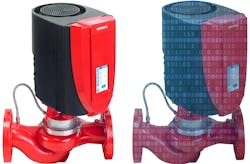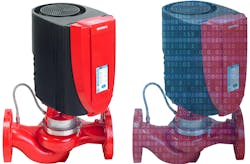Advantages of Digital Twins in HVAC Systems: A Primer
The growing use of digital twins as a key strategy in manufacturing and systems optimization has left many designers, installers, operators and building owners wondering about the technology and what benefits it might have for the modern built environment, and specifically HVAC systems.
So what is a digital twin?
Imagine compiling a database that included every conceivable piece of information on an installed product. Every measurement, every component, every supplier, every line of code, in every version of firmware used, operating history, performance history, maintenance records, service records, etc. Everything. All that information archived together, but separate from the actual product, is effectively a digital twin of that product.
Simply put, a digital twin is a virtual representation of a physical object or system. A digital twin can and usually does function throughout the lifecycle of a product, using real-time data to enable deeper understanding, learning and reasoning.
IBM also provides this helpful explanation in an article on its IoT blog, Digital Twin: Helping machines tell their story (www.ibm.com/internet-of-things/trending/digital-twin):
“Digital twins allow operators to capture, convey and operationalize real-world insights to improve operational yields and asset performance in the field. Digital twin replicas can be used to model how physical assets will perform under certain conditions and to help monitor asset performance in real time.”
In his own 2014 artcile, Digital twin: manufacturing excellence through virtual factory replication, Michael W. Graves explained the benefits for a manufacturing environment:
“In the past, factory managers usually occupied an office that overlooked the factory so that they could get a feel for what was happening on the factory floor. With digital twin technology, everyone associated with factory production could have a similar, virtual, digital window with sightlines to not just one single factory, but to all of an organization’s factories, all across the globe.”
A useful next step for further understanding of digital twin technology might be an examination of some of the key characteristics of digital twins. The following list, drawn from the Wikipedia page on the topic, should not be considered exhaustive, but it is still useful, nonetheless.
Connectivity
Digital twin technology both enables and depends on connectivity to and between organizations, products, and customers.
Homogenization
Any type of content can now be stored and transmitted in the same (homogenous) digital form. The data can be used to create a virtual representation of the product. This decouples the information about a piece of equipment from its physical form and makes the digital twin possible.
Reprogrammable and Smart
Most modern equipment solutions are now an integration of mechanical and digital capabilities, so a digital twin makes a product reprogrammable in an automatic manner, effectively creating a new version. This also gives manufacturers the ability to observe a digital twin, and make adjustments to the equipment in much the same way that consumer level computing devices auto-update.
Digital traces
Digital twin technologies create digital records that can be useful for tracing histories. These can be used by engineers when a machine malfunctions to diagnose where the problem occurred. These same digital traces can also be useful to manufacturers as they work to improve on their designs for future product releases.
Modularity
Manufacturers can leverage digital twin technology to review detailed performance data. As a result, they can see which components make a machine perform poorly and replace them with better components that improve results.
Applications of the Digital Twin concept
Digital twins can be used to address a range of problems that organizations face. Specifically applying that technology and capability to the world of HVAC, digital twins can be helpful with:
Tracking asset performance in real time to plan for maintenance and replacement;
Training staff to learn key aspects of operation and maintenance much more quickly;
Real-time decision-making, using repeated simulations and making adjustments to parameters;
Decommissioning resources using detailed performance records for end-of-life analyses.
Applications to HVAC and Building Performance
One part of the value the digital twins provides in operating equipment and systems is in the speed, accuracy and repeatability of analyses and decisions.
Given the information processing capabilities of modern IT systems, in a structured environment, with proper structure around information gathering, analysis, comparison and implementation, digital systems can bring a disciplined approach to the entire decision process. No human can, or would want to, match the processing capabilities of computers, specifically as they relate to capabilities in:
• Speed of problem identification;
• Speed of reaction;
• Accuracy in analysis;
• Accuracy in reaction;
• Accuracy in measuring and recording;
• Accumulation of learning;
• Retention of learning.
To provide some contrast, one might imagine a decision process and conversation in a building operating environment, sounding like this:
[Receipt of New Data] “Something’s wrong. The numbers are bad.”
[Search for Information, Seek to Understand] “What’s happening?”
[Review and Consider Options] “The last time we saw something like this it was X and we fixed it by Y. Let’s try that again and see what happens.”
[Implement] “That should do it.”
[Review, Evaluate] “Any change?”
“Seems to be working.”
“Let’s leave it set that way and see if anyone complains.”
While this is clearly an oversimplification and not reflective of the decision processes in place in many professionally run buildings, one can still imagine that conversations like this might occur.
Where humans are involved in decision-making processes, the many different types of bias that we bring to decisions can negatively affect the choices made. The world of psychology reveals many different types of individual biases that might come into play in the process of addressing performance issues related to HVAC systems.
Confirmation bias; Premature termination of search for evidence; Selective perception; Wishful thinking; Repetition bias; Anchoring and adjustment; Source credibility bias; Incremental decision-making and escalating commitment, etc. Any or all of these different types of bias, individually or in combinations, can undermine decisions related to equipment performance and management.
Employing digital twin technology, and applying the computing power available to the challenge of performance maximization can minimize or even eliminate these biases from the decision process around performance management.
More importantly a digital twin allows for testing scenarios in advance, separate from the physical system. This creates opportunities for operators to try out solutions, and know the results, before applying them to the real world equipment.
Pure Data Modeling Versus Equation-based Modeling
Armstrong has recently developed a new technology platform to help building managers and operators maximize system efficiency using a combination of automated self learning and cloud connectivity. Based on accumulated learnings of system operations, the platform adapts to best efficiency equipment settings for performance priorities, be they energy reduction, water conservation, noise management, peak demand chargers, or equipment capacity management.
At the foundation of the new platform is an innovative approach to creating digital twins that enables continuous learning cycles to achieve and maintain persistent building performance.
Evolving Performance Maps vs. Static Equation-based Protocols
Static equations, and feedback control loops are fixed to an initial commissioned state and don’t evolve. Over time, this creates a gap between actual performance levels, and the system performance that was predicted or promised upon installation.
As one part of creating a digital twin, the platform builds a data-driven model of plant equipment stations, referred to as equipment performance maps. The maps are a correlation between equipment input and output, with reference to varying heat loads. Performance maps evolve in conjunction with the mechanical system conditions and the addition of new data.
Persistence is a key aspect of performance optimization. Conceptually, the algorithm endlessly repeats these steps:
1. Review and compare equipment performance maps;
2. Determine the best equipment settings and plant configuration;
3. Sort all valid combinations by totalized power;
4. Select a combination of equipment maps for lowest power consumption.
Rather than be 100% dependent on the latest calculation, or the last established result of these steps, the digital twin is constantly maintaining a scorecard of performance results. The digital twin model will automatically implement the best calculated combinations, but only if more than a predetermined percentage of performance results are better than the existing, installed performance maps on the physical equipment.
Of course, as the plant continues to operate, the digital twin is updated with the real time data. By consistently prioritizing the most efficient combination of equipment, this approach achieves the lowest consumption of the combined devices while satisfying the load.
The application of computing technology to the search for better combinations of setting means HVAC systems can maintain, or even improve, plant performance through codified persistence.
Preventing Drift and Perfecting Maintenance
Through recording the best observed performance combination, any deviation from a previous behavior is recorded. At that point, the platform can establish any drift in system performance. The predictive optimization therefore adapts and adjusts accordingly, maintaining the lowest plant performance, while detecting the anomaly.
In parallel, it also flags the device for any service, maintenance or repair. Getting an early diagnostic allows the system to recover faster and bring it back to its early performance.
Improving overall asset performance, increasing system efficiency, and optimizing asset behavior all help a reliability engineer to predict and manage risk based on high quality data rather than assumptions based solely on experience.
This presents an example of the type of application in which digital technology in the form of a digital twin, can be very valuable. With more widespread application and feedback provided by a user community, further refinement of the technology and development of even more applications seems assured.
For now, it’s informative to review early applications and certainly advisable to consider using the digital twin for more HVAC projects in the near future.

